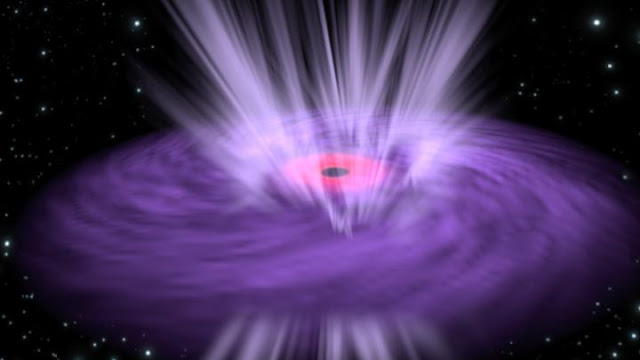

| Online: | |
| Visits: | |
| Stories: |

| Story Views | |
| Now: | |
| Last Hour: | |
| Last 24 Hours: | |
| Total: | |
Black Hole Burps Ultrafast Winds That Affect Galaxy’s’ Growth
Scientists have now made the most detailed observation yet of such an outflow, coming from an active galaxy named IRAS 13224-3809. The outflow’s temperature changed on time scales of less than an hour, which is hundreds of times faster than ever seen before. The rapid fluctuations in the outflow’s temperature indicated that the outflow was responding to X-ray emissions from the accretion disk, a dense zone of gas and other materials that surrounds the black hole.
This is an artist impression illustrating a supermassive black hole with X-ray emission emanating from its inner region (pink) and ultrafast winds streaming from the surrounding disk (purple).

Credit: The European Space Agency (ESA)
“Although we have seen these outflows before, this observation was the first time we were able to see the launching of the gases being connected with changes in the luminosity of black holes,” said Erin Kara, a postdoctoral researcher in astronomy at the University of Maryland and a co-author of the study.
Scientists made these measurements using two space telescopes, NASA’s NuSTAR (Nuclear Spectroscopic Telescope Array) telescope and the European Space Agency’s (ESA) XMM-Newton. To capture the variability of these signals, scientists focused the XMM-Newton on the black hole for 17 days in a row, and observed the black hole with NuSTAR for six days.
To measure the temperatures of these winds, scientists studied X-rays coming from the edge of the black hole. As they travel towards Earth, these X-rays pass through the outflows. Elements such as iron or magnesium present in the outflows can absorb specific parts of the X-ray spectrum, creating signature “dips” in the X-ray signal. By observing these dips, called absorption features, astronomers can learn what elements exist in the wind.
The team noticed that the absorption features disappeared and reappeared in the span of a few hours. The researchers concluded that the X-rays were heating up the winds to millions of degrees Celsius, at which point the winds became incapable of absorbing any more X-rays.
The observations that the outflows appear to be linked with X-rays, and that both are so highly variable, provide possible clues for locating where exactly the X-rays and outflows originate.
“The radiating gas flows into black holes are most variable at their centers,” Kara said. “Because we saw such rapid variability in the winds, we know that the emission is coming from very close to the black hole itself, and because we observed that the wind was also changing on rapid time scales, it must also be coming from very close to the black hole.”
To further study galaxy formation and black holes, Chris Reynolds, a professor of astronomy at UMD and a co-PI on the project, noted the need for more detailed data and observations.
“We need to observe this black hole with better and more spectrometers, so we can get more details about these outflows,” Reynolds said. “For instance, we don’t know whether the outflow is composed of one or multiple sheets of gas. And we need to observe on multiple bands in addition to X-rays–that would allow us to detect molecular gases, and colder gases, that can be driven by these high-energy outflows. All that information will be crucial to understanding how these outflows are connected to galaxy formation.”
University of Maryland
College of Computer, Mathematical, and Natural Sciences
Source:


